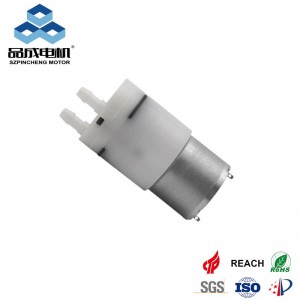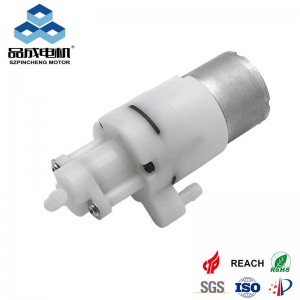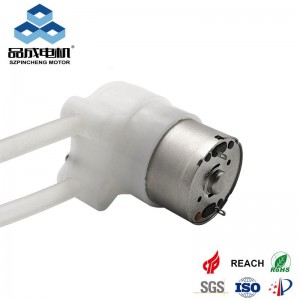Micro water pumps supplier
Micro diaphragm pumps are vital to medical devices, lab equipment, and precision industrial systems—yet noise and vibration remain persistent challenges. Excessive sound (>45 dB) or shaking can signal premature wear, inaccurate fluid handling, or even system failure. We dissect the science behind these issues and modern solutions to achieve whisper-quiet, stable operation.
Core Factors Driving Noise & Vibration
1. Fluid Dynamics: The Dominant Noise Source (>60% of total noise) 14
-
Pressure Pulsations: Rapid valve opening/closing creates pressure spikes during suction/discharge cycles, generating low-frequency noise (20–500 Hz).
-
Cavitation: At high temperatures or low vacuum, liquid vaporizes into bubbles that implode violently, causing high-impact vibration (>10 kHz) and component erosion 14.
-
Turbulence & Vortices: Unsteady flow in pipes excites structural resonance, amplifying noise by 6–15 dB 4.
2. Mechanical Forces: The Vibration Amplifiers
-
Diaphragm Flex Fatigue: PTFE/EPDM membranes endure 50–100 flex cycles/sec. Poorly balanced designs create asymmetric stresses, propagating micro-cracks and generating mid-frequency noise (500–2k Hz) 15.
-
Eccentric Drive Systems: Misaligned linkages or bearings induce unbalanced forces, accelerating wear on shafts and valves 18.
-
Valve Impact: Check valves slamming shut at >5 m/s produce sharp “ticking” sounds (>3k Hz) and shock waves 2.
3. Motor-Induced Noise: The Electrical Trigger 14
-
Electromagnetic Ripple: Uneven magnetic forces in brushed DC motors vibrate stators (120–240 Hz hum).
-
Bearing/Brush Friction: Imperfect rolling surfaces or commutator arcing adds broadband noise.
-
Cooling Fans: Turbulence from impellers contributes high-frequency whine (>8k Hz).
4. System-Level Resonance: The Silent Aggravator
-
Pipework Vibration: Rigid tubing magnifies pump pulsations, acting as a noise antenna 13.
-
Mounting Surfaces: Thin panels (<3 mm) resonate at 100–400 Hz, boosting perceived loudness by 12 dB 37.
Quantifying the Impact: Noise Sources by Severity
| Source | Frequency Range | Noise Increase | Vibration Amplitude |
|---|---|---|---|
| Cavitation | >10 kHz | +15–25 dB | High (>5 mm/s²) |
| Pressure Pulsations | 20–500 Hz | +8–12 dB | Medium (2–4 mm/s²) |
| Motor Magnetics | 100–500 Hz | +6–10 dB | Low (<1 mm/s²) |
| Valve Impact | 1–5 kHz | +4–8 dB | Medium-High (3–6 mm/s²) |
Proven Mitigation Strategies
A. Fluid Dynamics Optimization
-
Anti-Cavitation Designs:
-
Increase inlet pressure or reduce temperature to suppress bubble formation.
-
Use tapered valve seats to smooth flow transition, reducing pressure drop by 40% 4.
-
-
Pulsation Dampeners:
-
Install buffer tanks (>10% of pump displacement) or helical flow channels to absorb pressure spikes, cutting noise by 50% 46.
-
B. Mechanical & Material Upgrades
-
Balanced Diaphragms:
-
Curved PTFE membranes (e.g., KNF NMP 830) reduce bending stress by 30% vs. flat designs 5.
-
Nanocomposite coatings (e.g., graphene-PTFE) resist fatigue for 500,000+ cycles 4.
-
-
Low-Impact Valves:
-
Piezoelectric valves actuate in 2 ms (vs. 20 ms for springs), eliminating “water hammer” noise 7.
-
C. Motor & Drive Innovations
-
Brushless DC (BLDC) Motors:
-
Eliminate commutator noise and reduce electromagnetic harmonics by 90% 4.
-
-
Soft-Start Circuits:
-
Ramp voltage over 50–200 ms, preventing current surges that excite resonance 6.
-
D. System Integration Fixes
-
Vibration Isolation:
-
Use silicone-rubber mounts (<40 Shore A) or spring dampers to reduce structure-borne noise by 8–15 dB 35.
-
-
Acoustic Treatments:
-
Wrap pumps in micro-perforated foam (>30 PPI) or install expansion chambers to attenuate 125–500 Hz noise 47.
-
Case Study: Quieting a Medical Infusion Pump
-
Problem: 55 dB noise from cavitation and valve chatter disrupted patient sleep.
-
Solution:
-
Switched to BLDC motor + curved diaphragm
-
Added 20 ml buffer tank
-
Mounted with silicone isolators
-
-
Result: Noise reduced to 39 dB (below ICU night-time standards) 4.
Best Practices for Engineers
-
Avoid Dry Running: >5 minutes without fluid triples diaphragm stress 1.
-
Use Flexible Tubing: 30 cm silicone hoses cut pipe resonance by 70% vs. rigid PVC 3.
-
Monitor Temperatures: >80°C accelerates PTFE aging—derate pump speed if needed.
-
Specify Stability-First Pumps: Models like Pinmotor’s WhisperSeries integrate BLDC motors, dampened valves, and IoT vibration sensors for real-time health tracking.
Future Trends: Smart & Silent Pumps
-
Active Noise Cancellation: Microphones + counter-phase speakers nullify 100–800 Hz tones (lab-proven 12 dB reduction).
-
Self-Diagnostic Membranes: Strain sensors embedded in diaphragms predict failure at 80% fatigue life 5.
"In microfluidics, silence isn’t a luxury—it’s the signature of precision engineering."
Design Quieter Systems:
→ Explore Low-Noise Micro Diaphragm Pumps
→ Download Vibration Control Guide
you like also all
Read More News
Post time: Jul-22-2025




